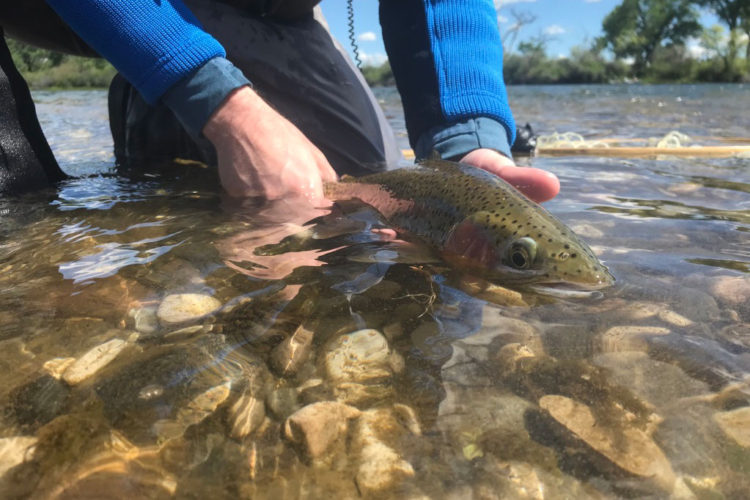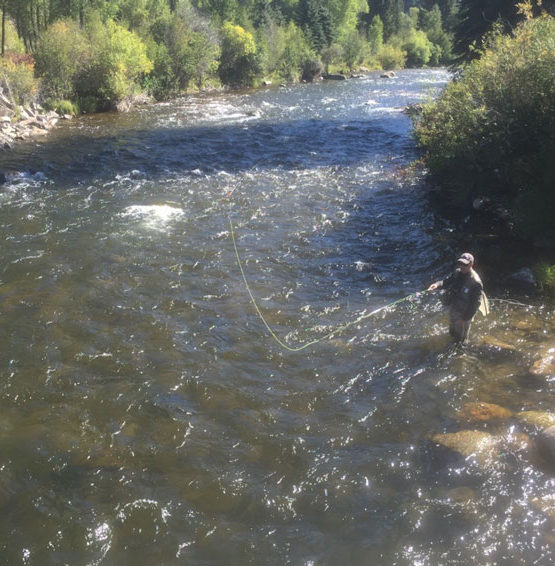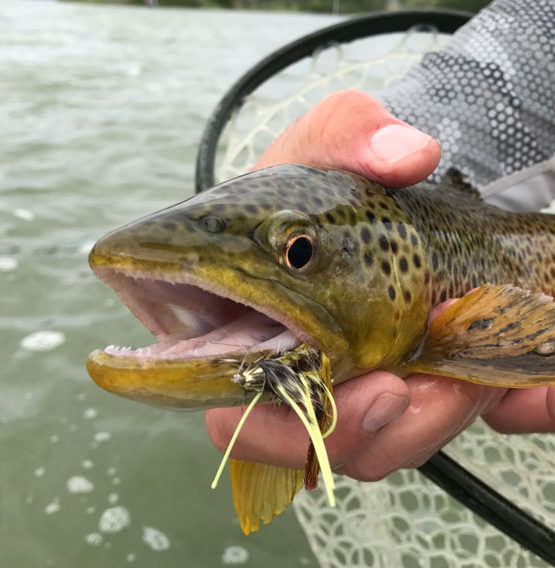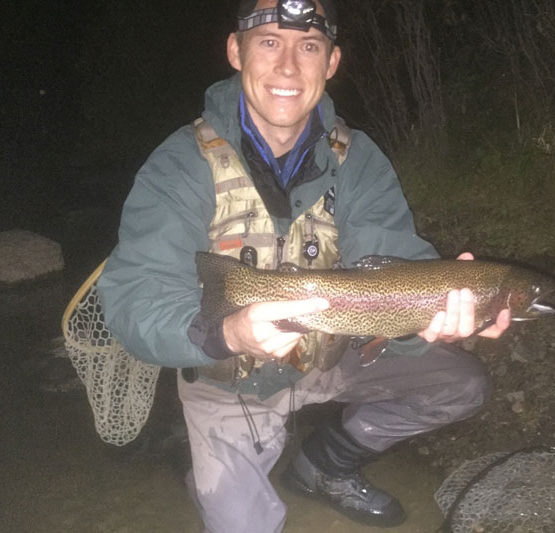I like to think I learned to nymph before nymphing was really a thing. A little background…
I was incredibly blessed to be born and raised in Colorado. We lived in Denver but always had a second mountain home in Breckenridge. When Friday afternoon rolled around, my dad would arrive home from work early and, as soon as my brother and I got home from school, we’d go about the business of packing up the car to head to the hills.
Our mountain home was a place of peacefulness, family fun and a wide assortment of activities and memories.
Mostly though, in the winter, we skied. In the summer, we fished.
In a scene reminiscent of A River Runs Through It, nearly every summer or fall morning, my brother Mike and I would get up early, dress and throw on our hip waders and vests. We’d sling our creels over our shoulders, make sure our cool-as-can-be fishing knives were correctly sheathed and hung, cowboy-style, at our sides, and then we’d grab our always-ready fly rods for our next crack-of-dawn fishing adventure.
(My dad, a terrific wood worker and carpenter, had built a sweet, dual-purpose ski and fly-rod rack that was hung strategically near our cabin’s walk-out basement door.)
Geared up and eager, we’d hike down to one of our favorite fishing spots: a long and widely-spaced series of beaver ponds known as Christy Heights. It was only about an eighth of a mile away.
On the way there, we’d argue about which one of us would get to hit which pond first. The younger brother, I almost always lost. Looking back on those brotherly spats, it really didn’t matter; every pond was home to a slew of beautiful mountain brook trout and a well-casted, well-placed fly of nearly any variety would almost always draw a strike.
Quickly limiting out was not uncommon, nor was a fresh brook trout breakfast shortly thereafter. A fabulous cook, our mom would fry ‘em up and serve them along with a bowl of cereal, a half grapefruit, eggs, coffee cake, fresh-squeezed orange juice and sometimes a slice of bacon or two.
Forty plus years later, I can still taste that breakfast as if she’d served it this morning.
So, you might be asking, what does this story have to do with nymphing tips for beginners? Hang on, I’m getting there…
Before the days of fly boxes, my brother and I carried what could best be described as fly wallets. My dad, God rest his soul, had always stocked them with a series of dry flies: Adams, Royal Coachmen, Mosquitoes, Irresistibles, Humpys, Caddis — the usual Colorado Mountain array. Next to the dries, he’d have also loaded up what would become our go-to fly: a Rio Grande King, which, thinking back on it, probably mimicked a horse fly more than anything.
The unusual thing about these particular flies was that my dad would have “snelled” them with a short, three or four inch section of leader featuring the fly on one end and a small loop on the other. This setup made it easy for young, impatient fly fishermen to quickly switch out a fly. We’d simply attach them to a pre-knotted loop at the end of our leader with a basic handshake knot. Easy-peasy, lemon squeezy!
By today’s standards, it was a rather clunky rig, but it attracted mountain brook trout like the Nordstrom shoe department attracts my wife. We fished these pre-prepared Rio Grande Kings without dry-fly floatant — impatient boys aren’t inclined to dress flies after every strike or catch. Because of this neanderthal setup, our flies would get quickly water-logged. This meant that they would sink below the surface, and that’s where the magic happened; mountain brook trout attacked those bad boys like it was their last meal. Oh, I guess, in most cases, it was. Too soon?
Technically, although we had no idea about any such things back then, we were fishing dry flies “wet.” But let’s call it what it really was… We were, in essence, nymphing.
Related Content:
- 11 Tips For Night Fishing The Taylor River
- Head Cement vs. Super Glue: What’s The Difference?
- Can You Fly Fish Anywhere?
So what is nymphing and why should a beginning fly fisher want to learn how to do it?
It’s a generally accepted notion that the majority of a trout’s diet is made up of subsurface edibles; mostly aquatic born flies in their pupa and larval stages, annelids and crustaceans. Generally speaking, fishing imitations of these categories, subsurface, and most often with weights and strike indicators, is known as nymphing.
By contrast, dry fly fishing — fishing an adult fly or terrestrial bug (ant, grasshopper, beetle) imitation — conjures the classic image many a mind’s eye pictures when thinking of fly fishing.
When conditions are right, dry fly fishing is, in a word, awesome, but success with a dry fly rig can also be frustratingly fickle, especially for a newbie. As a beginner, if dry fly fishing is all you attempt, fly fishing may not (pardon the pun) hook you.
Since fish tend to be lazy and, as such, feast on underwater food most of the time, it’s logical that getting your imitation flies down to them greatly improves your odds of catching more of them, right?
Additionally, this subsurface feeding takes place throughout the year, regardless of season, so a good nymph fisher can fish year-round. Thus, nymphing is an essential skill every fly fishing beginner must learn.
So, as promised, here are 9 killer nymphing tips to catch more fish.
#1 – Keep your rig simple
You’re a beginner. Just because your more experienced buddies might be rigging up with a double or triple nymph rig doesn’t mean you should. Keep in mind that, while more practiced fly fishers will want to present more than one fly at a time, the more complicated your rig, the more likely it is to snag or gnarl, and the more difficult it will be for you to change. Stick with a simple, one nymph rig at first. As you get better and more confident, you can push the envelope. But for the time being, and your sanity, KISS (keep it simple, stupid).
#2 – Learn to roll cast
The roll cast is the go-to cast for a nymphing situation. It’s simple, relatively easy, and reduces the probability of trouble (snags, gnarls, a hook embedding in your earlobe, etc.). There are different types of roll casts for different situations, but learning to roll cast, along with the variations thereof, will serve you well when nymphing. Learn it. Love it. Live it.
#3 – Determine proper depth (and be willing to change often)
Other than fly selection, perhaps the most important ingredient in your nymphing success is rig depth and depth adjustment. As mentioned above, fish are fairly lazy and, thus, tend to feed closer to the river bed where the current is less intense (more about where fish congregate in future posts). As cold blooded creatures, the colder the water, the less fish will be willing to move to eat a morsel of food. Assuming your nymph-fly mimics an in-season, actively hatching bug, a well-drifted, natural looking nymph that happens to float by a feeding fish within inches of his or her mouth will usually draw a strike. Generally speaking, however, the less a fish has to move to eat your fly, the more difficult it will be for you to detect a take (see tip #8 below). As you get better, you’ll find out soon enough that it’s not uncommon to actually see your nymph float barely an inch or two, right over a big trout, and watch the jerk ignore it like a super model does a guy with a small bank balance. Simply changing the position of your weight to close that gap can mean the difference between a multi-fish day and getting skunked.
#4 – Learn how to mend your line for drag-free drifts
Funny thing about wildlife, they all seem to possess either an innate, learned (or both) sense of danger. Troutville’s inhabitants are especially wary of threats from above: eagles, bears… you, to name just a few. In most reasonably accessible fishing spots, trout are usually highly discerning when it comes to what real food looks like and what fake food (with a secret hook hidden inside) looks like. The dead giveaway? Any indication of unnaturalness, i.e. a poorly drifted fly. So, to increase your odds of success, it is, again, rather logical to get better at executing good drifts. The process of eliminating drag (to the degree possible when casting a tiny fly attached to the end of a long string across a strong river current) at the business end of your fly fishing rig is known as “mending your line.” As simple an explanation as I can muster, mending is best done by using the tip of your rod to flip the current-influenced loop that develops when fishing line is laid across a river current, either upstream or downstream to, in essence, stop the current from tugging your line and fly unnaturally through the water. One good rule of thumb to help you determine if you’re mending correctly is to watch your strike indicator as well as the end of your colored fly line. If both of those are drifting naturally with the current, it’s a good bet that your underwater nymph is too. Incidentally, if you’re casting up-river, ahead of a likely fish holding spot, you will want to mend quickly to achieve a drag-free drift just as your fly hits the targeted stretch of river. Depending upon river clarity, a trout’s range of vision is fairly limited, so if you’re able to achieve even a good, though short-lived, drift through the feeding zone, it may be enough to draw a strike. Excuse the alliteration but I sometimes think: free for a few feet fools fish frequently. The moral of this story? Work on your line mending prowess to improve your fish-catching opportunities.
#5 – Try The High Sticking Method
As with jewelry, when it comes to nymphing, big things often come in small packages. One of our favorite nymphing techniques is to employ the high (or short) stick method.
This involves keeping your line and cast a bit shorter, casting up river, mending your line upstream a time or two and, as your fly drifts down, you draw in and raise your rod so that the grip is held high above your ear. At this point in the drift, your fly line should no longer be touching the water.
As your fly rig goes by and through the money zone, only leader, weight(s), tippet and flies should be in the water. Further down, once it has passed you, you’ll lower your rod, mend a couple of times and finish your drift. We can’t tell you how often this technique draws not only a strike, but, at the pinnacle of the high-stick raise, a ferocious one.
While line mending keeps your fly drifting naturally, the high-stick technique produces what appears to be an aquatic-born insect in its emerging state — when it’s swimming to the surface to start the process of becoming an adult fly. Feeding trout sometimes lose their minds when they see this and can’t help but attack. Try it. We think you’ll like it.
#6 – Let It Swing
After you’ve worked hard to get your rig dialed in, have positioned yourself in a good casting spot, made a good cast, mended your line well, achieved a nice and natural drift and, near drift’s end, are getting ready to cast again, we say, let it lay, abandon your conscientious mending, and let your nymph swing!
What? Let it swing? I thought you said we shouldn’t let it be tugged unnaturally!
Well, yes, while all of that is true, we do recommend letting your line swing at the tail end of your drift.
If you commit to nymphing, it won’t be long until you go to make your next cast only to notice that you’ve just hooked up on a nice fish! As your nymph rig nears the end of its drift, if you let it swing while slowly raising your rod tip as you would when getting ready to cast again, your imitation nymph takes on the appearance of an emerging insect and, as with the high-stick technique, often prompts a strong take.
What’s even better, when a fish hits a fly “on the swing” he or she is often well hooked, which will come in handy when trying to land an angry trout that is already down river of you. Have fun!
#7 – Practice patience
My dad was the patron saint of fly fishing patience. I can’t tell you how often my brother and I would fish a hole for five minutes then tromp on through it to the next hole, only to watch him move into the vacated spot, let the dust settle for a few minutes, then start to work it: quietly, methodically, patiently, until he was hauling in trout that we were too hasty to earn.
Now a patient fly fisherman, I have become my dad. So has my son. It’s not uncommon for the two of us to wait for other people to move on from a hole we like because they haven’t caught anything (or not enough to hold their interest) then move in and work it patiently until we’re slaying it for the next several hours.
Does it always happen?
No, but, in our opinion, patience yields success a lot more frequently than the alternative.
Many would disagree, but if you practice patience while changing flies, working on depth adjustment, trying different casting and drifting techniques, moving a little up or down, casting longer, casting shorter, waiting for a passing rain to produce a hatch before moving on, we guarantee you’ll create a lot of epic and memorable episodes in your fly fishing life.
#8 – Set the hook
I’m sure many a fly fishing guide will nod emphatically at this next statement: the hardest thing for a beginning fly fisher to do is to detect a strike and set the hook. Since a lot of thinking and things heretofore unpracticed, come into action all at once, it’s understandable that when that thing that you’re trying so hard to make happen suddenly happens, it’s easy to spaz out and completely blow your chance.
The dry-fly hook-set freak out is a story for another blog post, but the nymphing hook-set can be just as spasm-inducing, although, in most cases, you’ll be reacting to the movement (or sudden lack thereof) of your strike indicator.
Sometimes (and just writing this is nearly as thrilling as when it happens), your lilting strike indicator will suddenly dart seven feet to one side or the other or downward.
Other times, you’ll see, out of the corner of your eye, a trout sky out of the water, just down from your indicator and, within a millisecond, your indicator will come out of the water with it. In these types of instances, it’s pretty clear that a fish has attacked your nymph like it stole something.
More often, however, a strike is much more subtle. It’s a slight hesitation in your indicator’s drift: a micro-scootch to one side or the other, a bob that looks exactly like your indicator does when passing over a wave.
The good news is that the “tug is the drug” and after a few missed sets, you’ll get the hang of it and start hooking fish. And that’s when you’ll become hopelessly lost in the obsession that is fly fishing.
Welcome to it, friend.
#9 – Don’t Mess With a Successful Rig
Though my aging databank seems to be missing a few files, it still holds a vivid memory.
My son and I were are fishing the Bighorn River with a group of lifelong buddies and their sons, when we all learned a stark lesson in stick-to-your rig mentality. All accomplished fly fishermen, we were working various locations around one of the Bighorn’s famous mid-river islands, and all to rather ho-hum results.
Suddenly something changed… one of us got hot. Blisteringly so — hooking big rainbows and browns on nearly every cast. It wasn’t long before the rest of us, all still fairly cold, became aware of this vexing development.
Soon we were pressing him on what nymphs he was using, how much weight he had on, how long his leader and tippet were and nearly as soon, we had all changed out our rigs to match. It didn’t matter. He stayed hot. We stayed cold. And that remained the situation until we got into our boats, pulled up anchor and floated down river.
He was all smiles. The rest of us were a tad grumpy. Later that evening, over a few cold ones, we all rehashed the scene. Laughing now at how frustrated we all were watching him haul in trout after trout, we concluded that sometimes you just land on the perfect rig, at the perfect time of day, on the perfect spot and… well, fireworks.
I asked him if, during his sizzling streak, he ever changed out a fly or adjusted his rig. His response? A hearty, “Hell no!” (ask a silly question).
By the time he was done, his nymphs were mangled, his line was frayed and his forearm ached, but, as any good baseball manager would applaud, he didn’t change a thing and rode out his winning streak for as long as it lasted.
Hot streaks happen and, when they do, stick to your rig and squeeze it for all it’s worth. When it ends, they’ll have to pry the smile off your face with a crowbar.
Final Thoughts
I’ve known fly fishermen who, holding to some weird purist mentality, only fish dry flies. At some level, I guess I get it. Dry fly fishing is elegant, sublime, indeed, ethereal, and those of that mindset have chosen to forego the more brutish practice of nymphing (that, or they just don’t want to commit to learning how).
But significantly more often than not, dry flies are not the bug of choice for feeding fish. And while fly fishing, regardless of frequency of catch, is as peaceful and soul-settling as just about anything I can think of, call me crazy, but it’s a heck-of-a lot more fun to go fishing and actually catch lots of fish.
Learning to nymph well will absolutely ensure your growth and success as a fly fisher. Commit to making it your go-to method and even the slowest day on the water can be salvaged.
Just don’t forget your crowbar!
Disclaimer: This post may contain affiliate links, meaning we will receive a small commission (at no cost to you) if you click through and make a purchase.










Zen and the art of Nymphing uh huh it rocks…. next let’s see a post on streamer fishing another “killer” technique that needs to be in every fly-fisherman’s arsenal and may provide the most exciting takes as the angler watches and anticipates the strike of a fired up trout in pursuit of its next meal!
Thanks for the comment, Dave… Streamers are definitely on our radar. Keep an eye out for our next post. It’ll be live shortly.
MB
As a new fly fisher, and living in Colorado I throughly enjoy reading all of your material.
Thank you for the kind words, Rob. We love hearing that our readers are enjoying and benefitting from our content. Be sure to let us know how you’re doing as your fly fishing passion and expertise grow!
While I’ve always been an avid fisherman, I’ve just recently committed to learning and developing the art of fly fishing (I’m 3 only weeks in). Your site (and this post specifically) has been a tremendous guide, and has aided in yielding good, quick results too! Thank you for what you do here to help guide the wandering, lost students of the streams
That’s awesome! Won’t be long before you become an avid fly fisherman (if that hasn’t happened already). We hope this post about nymphing techniques continues to help and to be a good reference for you. We also hope that you’ll come back to Fly Fishing Fix often. Best wishes, Jimmy, and welcome to our world!